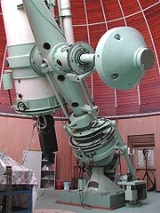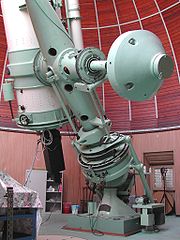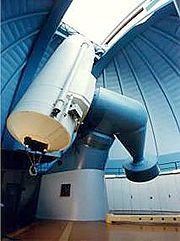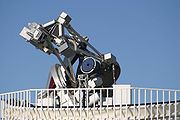
Telescope mount
Encyclopedia

Telescope
A telescope is an instrument that aids in the observation of remote objects by collecting electromagnetic radiation . The first known practical telescopes were invented in the Netherlands at the beginning of the 1600s , using glass lenses...
. Telescope mounts are designed to support the mass of the telescope and allow for accurate pointing of the instrument. Many sorts of mounts have been developed over the years, with the majority of effort being put into systems that can track the motion of the stars as the Earth rotates.
Fixed mounts
Fixed telescope mounts are entirely fixed in one position, such as Zenith telescopeZenith telescope
A zenith telescope is a type of telescope that is designed to point straight up at or near the zenith. They are used for precision measurement of star positions, to simplify telescope construction, or both....
s that point only straight up and the National Radio Astronomy Observatory
National Radio Astronomy Observatory
The National Radio Astronomy Observatory is a Federally Funded Research and Development Center of the United States National Science Foundation operated under cooperative agreement by Associated Universities, Inc for the purpose of radio astronomy...
's Green Bank fixed radio 'horn
Horn (telescope)
A horn is a stationary radio telescope. Horns were originally built to observe specific objects in the sky, and preceded the more commonly known movable dishes used today.-See also:* Feed horn* Horn...
' built to observe Cygnus X-1
Cygnus X-1
Cygnus X-1 is a well-known galactic X-ray source in the constellation Cygnus. It was discovered in 1964 during a rocket flight and is one of the strongest X-ray sources seen from Earth, producing a peak X-ray flux density of 2.3 Wm−2Hz−1...
.
Fixed altitude mounts
Fixed-altitude mounts usually have the primary optics fixed at an altitudeAltitude
Altitude or height is defined based on the context in which it is used . As a general definition, altitude is a distance measurement, usually in the vertical or "up" direction, between a reference datum and a point or object. The reference datum also often varies according to the context...
angle wile rotating horizontally (in azimuth). They can cover the whole sky but only observe objects for the short time when that object passes a specific altitude and azimuth.
Transit mounts
Transit mounts are single axis mounts fixed in azimuth wile rotating in altitude, usually oriented on a north-south axis. This allows the telescope to view the whole sky, but only when the Earth's rotation allows the objects to cross (transit) through that narrow north-south line (the meridianMeridian (astronomy)
This article is about the astronomical concept. For other uses of the word, see Meridian.In the sky, a meridian is an imaginary great circle on the celestial sphere. It passes through the north point on the horizon, through the celestial pole, up to the zenith, through the south point on the...
). This type of mount is used in Transit telescopes, designed for precision astronomical measurement. Transit mounts are also used to save on cost or where the instruments mass makes movement on more than one axis very difficult, such as large radio telescope
Radio telescope
A radio telescope is a form of directional radio antenna used in radio astronomy. The same types of antennas are also used in tracking and collecting data from satellites and space probes...
s.
Altazimuth mounts
Main article: Altazimuth mountAltazimuth mount
An altazimuth or alt-azimuth mount is a simple two-axis mount for supporting and rotating an instrument about two mutually perpendicular axes; one vertical and the other horizontal. Rotation about the vertical axis varies the azimuth of the pointing direction of the instrument...

Amateur astronomy
Amateur astronomy, also called backyard astronomy and stargazing, is a hobby whose participants enjoy watching the night sky , and the plethora of objects found in it, mainly with portable telescopes and binoculars...
.
Besides the mechanical inability to easily follow celestial motion the altazimuth mount does have other limitations. The telescope's field-of-view rotates at varying speed as the telescope tracks, whilst the telescope body does not, requiring a system to counter-rotate the field of view when used for astrophotography
Astrophotography
Astrophotography is a specialized type of photography that entails recording images of astronomical objects and large areas of the night sky. The first photographs of an astronomical object were taken in the 1840s, but it was not until the late 19th century that advances in technology allowed for...
or other types of astronomical imaging. The mount also has blind spot or "zenith hole", a spot near the zenith where the tracking rate in the azimuth coordinate becomes too high to accurately follow equatorial motion.
Alt-alt (altitude-altitude) mounts
Alt-alt mounts, or altitude-altitude mounts, are designs similar to horizontal equatorial yoke mounts or Cardan suspension gimbalGimbal
A gimbal is a pivoted support that allows the rotation of an object about a single axis. A set of two gimbals, one mounted on the other with pivot axes orthogonal, may be used to allow an object mounted on the innermost gimbal to remain immobile regardless of the motion of its support...
s. This mount is an alternative to the altazimuth mount that has the advantage of not having a blind spot near the zenith, and for objects near the celestial equator
Celestial equator
The celestial equator is a great circle on the imaginary celestial sphere, in the same plane as the Earth's equator. In other words, it is a projection of the terrestrial equator out into space...
the field rotation is minimized. It has the disadvantage of having all the mass, complexity, and engineering problems of its equatorial counterpart, so is only used in specialty applications such as satellite tracking. These mounts may include a third azimuth axis (an altitude-altitude-azimuth mount) to rotate the entire mount into an orientation that allows smother tracking.
Equatorial mounts

Equatorial mount
An equatorial mount is a mount for instruments that follows the rotation of the sky by having one rotational axis parallel to the Earth's axis of rotation. This type of mount is used for astronomical telescopes and cameras...
The equatorial mount has north-south "polar axis" tilted to be parallel to Earth's polar axis that allows the telescope to swing in an east-west arc, with a second axis perpendicular to that to allow the telescope to swing in a north-south arc. Slewing or mechanically driving the mounts polar axis in a counter direction to the Earth's rotation allows the telescope to accurately follow the motion of the night sky. Equatorial mounts come in different shapes, include German equatorial mounts (GEM in short), equatorial fork mounts, mixed variations on yoke or cross-axis mounts, and equatorial platform
Equatorial platform
An equatorial platform or equatorial table is an equatorial telescope mount in the form of a specially designed platform that allows any device sitting on it to track astronomical objects in the sky on an equatorial axis. They are used to give equatorial tracking to any device sitting on them, from...
s such as the Poncet Platform
Poncet Platform
A Poncet Platform or Poncet mount is a type of equatorial platform that uses a simple polar pivot and an inclined plane. The motion of the mount allows any device sitting on that platform to track the apparent motion of the stars in the night sky...
.
Tilting the polar axis adds a level of complexity to the mount. Mechanical systems have to be engineered to support one or both ends of this axis (such as in fork or yoke mounts). Designs such as German equatorial or cross axis mounts also need large counter weights to counter balance the mass of the telescope. Larger domes and other structures are also needed to cover the increased mechanical size and range of movement of equatorial mounts. Because of this, equatorial mounts become less viable in very large telescopes and have been pretty much replaced by altazimuth mounts for those applications.
Hexapod-Telescope

Instead of the classical mounting using two axle
Axle
An axle is a central shaft for a rotating wheel or gear. On wheeled vehicles, the axle may be fixed to the wheels, rotating with them, or fixed to its surroundings, with the wheels rotating around the axle. In the former case, bearings or bushings are provided at the mounting points where the axle...
s, the mirror is supported by six extendable strut
Strut
A strut is a structural component designed to resist longitudinal compression. Struts provide outwards-facing support in their lengthwise direction, which can be used to keep two other components separate, performing the opposite function of a tie...
s (hexapod). This configuration allows moving the telescope in all six spatial degrees of freedom and also provides a strong structural integrity.
See also
- GoTo (telescopes)GoTo (telescopes)In amateur astronomy, "GoTo" refers to a type of telescope mount and related software which can automatically point a telescope to astronomical objects that the user selects...
- History of the telescope
- List of telescope parts and construction
- List of telescope types

